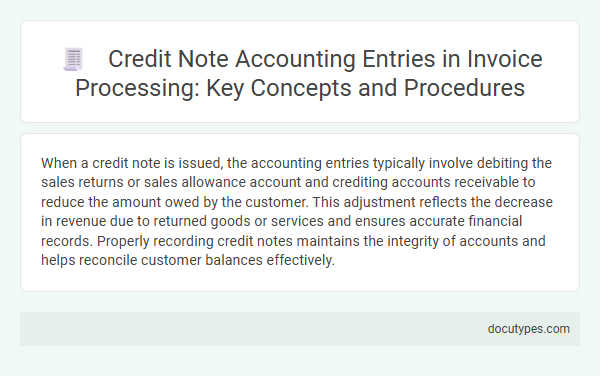When a credit note is issued, the accounting entries typically involve debiting the sales returns or sales allowance account and crediting accounts receivable to reduce the amount owed by the customer. This adjustment reflects the decrease in revenue due to returned goods or services and ensures accurate financial records. Properly recording credit notes maintains the integrity of accounts and helps reconcile customer balances effectively.
Introduction to Credit Note Accounting in Invoice Processing
A credit note serves as a formal document issued to correct or reverse an invoice amount. It plays a crucial role in adjusting accounting records within invoice processing.
- Debit Entry to Sales Returns - Reduces revenue by acknowledging returned goods or services.
- Credit Entry to Accounts Receivable - Decreases the amount owed by the customer, reflecting the adjustment.
- Impact on Tax Accounts - Modifies applicable tax liabilities or credits in accordance with the credit note.
Accurate accounting entries from credit notes ensure transparent financial reporting and customer account management.
Understanding Credit Notes: Definition and Purpose
A credit note is a document issued by a seller to a buyer, indicating a reduction in the amount owed. It serves as evidence that the seller has acknowledged a return, discount, or correction in the original invoice.
Credit notes adjust the buyer's account balance and ensure accurate financial records. They play a crucial role in accounting by reversing or reducing previously recorded sales revenue.
Common Scenarios Requiring Credit Notes in Invoicing
Credit notes are essential documents issued to adjust invoices by reducing the amount billed to a customer. They impact accounting records by reversing or modifying previously recorded sales and receivables.
- Return of Goods - Credit notes are issued when customers return products, requiring a reduction in accounts receivable and sales revenue.
- Pricing Errors - When an invoice includes incorrect pricing, a credit note corrects the overcharged amount by adjusting the sales and customer balances.
- Discount Adjustments - Credit notes apply when agreed discounts are not captured initially, reflecting the accurate transaction value in accounting entries.
Key Accounting Entries for Credit Notes
When a credit note is issued, the key accounting entries involve debiting the sales returns and allowances account to reduce revenue. The accounts receivable balance is credited to reflect the decrease in amounts owed by the customer. This ensures accurate recording of the reduction in sales and corresponding customer liability.
Double-Entry Bookkeeping for Credit Note Transactions
When a credit note is issued, double-entry bookkeeping requires recording a decrease in your accounts receivable and a corresponding reduction in sales revenue. The credit note entry debits the sales returns and allowances account, while crediting accounts receivable to reflect the returned or discounted amount. This ensures accurate financial statements by balancing the reduction in income with the decrease in customer payments owed.
Impact of Credit Notes on Accounts Receivable and Payable
Issuing a credit note reduces the outstanding balance in accounts receivable or accounts payable, reflecting the correction or return of goods or services. This adjustment ensures accurate financial records by reversing part or all of an existing invoice amount.
The impact of credit notes on accounts receivable and payable is crucial for maintaining precise customer and supplier balances.
- Reduction in Accounts Receivable - When a credit note is issued to a customer, it decreases the amount owed by that customer, lowering the accounts receivable balance.
- Reduction in Accounts Payable - Issuing a credit note to a supplier reduces the company's outstanding payable amount, adjusting the accounts payable accordingly.
- General Ledger Adjustment - Accounting entries debit sales returns or purchase returns and credit accounts receivable or payable to reflect the credit note's effect accurately.
Recording Credit Notes in Accounting Software
| Accounting Entry | Description | Impact on Accounts |
|---|---|---|
| Debit Sales Returns and Allowances Account | Records the reduction in sales revenue due to the credit note issued to the customer. | Decreases revenue in the income statement. |
| Credit Accounts Receivable | Reduces the customer's outstanding balance reflecting the credit note issued. | Decreases the asset balance on the balance sheet. |
| Debit VAT/GST Payable (if applicable) | Adjusts the tax liability by reducing the VAT or GST collected on the original sale. | Decreases current liabilities related to tax payable. |
| Recording in Accounting Software | Enter the credit note in the software by selecting the customer, referencing the original invoice, and inputting the amount credited. | Automates journal entries, updates accounts receivable, and adjusts sales and tax records. |
| Verify Entries | Confirm that both debit and credit postings correspond accurately to maintain balanced books. | Ensures accurate financial reporting and audit compliance. |
Credit Note Reconciliation and Audit Trail
When a credit note is issued, the accounting entries typically involve debiting the sales returns and allowances account and crediting accounts receivable. This adjustment reduces the outstanding customer balance and reflects the return or discount granted.
Credit note reconciliation ensures that the issued credit notes align accurately with the original invoices and customer accounts. Maintaining a proper audit trail records these transactions sequentially, supporting transparency and compliance during financial audits.
Best Practices for Credit Note Documentation
What accounting entries are made when a credit note is issued? When issuing a credit note, the accounts receivable balance is decreased to reflect the reduction in the amount owed by the customer. The sales revenue account is also adjusted to record the decreased sales due to the credit note.
What are best practices for credit note documentation? Maintaining detailed credit note records, including the original invoice reference and reason for issuance, ensures accurate financial reporting and audit trails. Proper classification and timely entry of credit notes into the accounting system enhance transparency and compliance with accounting standards.
What Accounting Entries Are Made When a Credit Note Is Issued? Infographic

